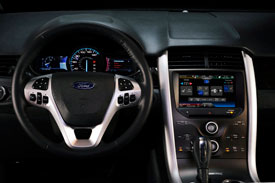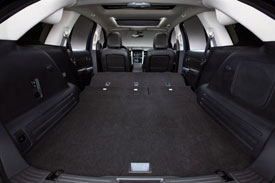2011 Ford Edge
For a brand known for its once top selling body-on-frame explorer SUV, the arrival of the 2006 Ford Edge midsize crossover utility really raised eyebrows. But Ford was just responding to the reality of surging gas prices and a flood of lighter, more efficient CUVs from import rivals. So, the Edge was a gamble that paid off. Now, Ford is doubling down with a mid-cycle edge revamp of the Edge. So let’s see if it’s again a winner.
Typical of what car makers call a freshening, the 2011 Edge maintains most of its exterior sheet metal, with major changes largely limited to front and rear fascias.
But, the addition of a big drop-jaw Ford-truck style grille, more expressive headlamp housings, and beefier wheels, does deliver a fresh impression, and makes the modern stance of the Edge even more so.
But, Ford smartly paid a lot more attention to upgrading the interior of the Edge. The instrument panel is improved in style, in fit and finish, with softer materials. Taurus influence is unmistakable.
Our well-equipped Edge Limited also included the latest Sync system which controls climate, stereo, navigation, and other functions.
Ford’s Sync voice recognition system has now morphed into MyFord Touch and it has three screens: two colorful info screens inside the gauge cluster, and a large touch screen in the center dash. Now it looks very much like a big smart phone display.
 And like a smart phone, there’s no tactile feel, so you have to look at the screen when you actually want to make a touch selection. We find that distracting—and it’s also annoying, especially when the system locks up like it did for us.
And like a smart phone, there’s no tactile feel, so you have to look at the screen when you actually want to make a touch selection. We find that distracting—and it’s also annoying, especially when the system locks up like it did for us.
Now there are redundant controls for stereo and climate below, but they’re very sensitive, so again you have to look at what you’re touching.
On the other hand, Sync’s voice command system and Bluetooth connectivity are improved, but they’re still just a little fussy.
The two gauge screens are controlled by five-way switches on the steering wheel. Of all the controls, they are the most intuitive to use.
Available SD-card based navigation adds some neat tricks, too, like buildings appearing in 3D. But the best news here is the addition of SYNC TDI, an On-Star-like voice-prompt navigation feature.
Systems like Sync and MyFord Touch may very well be the future of automotive controls. Still, we also hope efforts continue to make voice command systems more intuitive, since you don’t have to take your eyes off the road to use those.
Edge remains a five-passenger crossover. The new front seats are more comfortable but could still use more lateral support.
Ford’s unique door keypad is standard on all but base trim. Blind Spot Monitoring is an option.
 Rear seat space and comfort remain excellent, even for six-footers. That still leaves room for 32.2 cubic feet of cargo space behind a large opening hatch. And, folding the seats down brings that space to a competitive 68.9 cubic feet.
Rear seat space and comfort remain excellent, even for six-footers. That still leaves room for 32.2 cubic feet of cargo space behind a large opening hatch. And, folding the seats down brings that space to a competitive 68.9 cubic feet.
Base power for the Edge is still a 3.5-liter V6. But it’s smoother, with 285 horsepower, up 20, and 253 lb-ft of torque, up three.
New is the Mustang’s 3.7-liter V6 in the Edge Sport with 305-horsepower and 280 lb-ft of torque.
Front-drive six-speed automatics are fitted to both sixes with Sport trim adding paddle shifters. All-wheel drive adds new Hill Start Assist.
Still to come is an Edge Ecoboost, with a direct-injected, turbocharged 2.0-liter I-4. But, even without Ecoboost, Edge made gains in fuel economy.
Our front-drive 3.5 has government fuel economy ratings of 19 city, 27 highway. That’s up one in the city and two on the highway. On our test loop, we averaged 22.8 mpg of regular.
The Edge’s moderate Energy Impact Score of 15.6 barrels of oil per annum, and 8.5-ton Carbon Footprint, mirror those of the Toyota Venza V6.
Edge track performance was well above par: zero to 60 in 7.1 seconds, and the quarter mile in 15.7 seconds at 93 miles per hour. Power was best in the upper revs.
There was a fair amount of body roll through the slalom, but it had no notable affect on stability. The Edge Sport with its 22-inch wheels does even better.
The all-disc braking system is also new, from booster, to calipers, to first time Brake Assist. Our average 60-to-0 stopping distance of 129 feet was far better than the 146 feet in our previous test. Still, the 2011 Edge exhibited moderate fade and nose dive.
The Edge is a solid long distance highway tourer. Improved sound insulation, including acoustic glass, complement powertrain tweaks for impressively low noise at speed.
Pricing for a base Edge SE starts at $27,995. Our front drive Limited begins at $34,995, and the Sport at $36,995. All-wheel drive adds $1,850 more.
The improvements in the 2011 Ford Edge are extremely well-thought out. More tech, more comfort, and more all-around performance, without compromising its already strong five-passenger utility traits. It’s a perfect pairing for the all-new seven-passenger Explorer due soon. And that will make even more of a competitive edge for Ford’s rivals to worry about.
Specifications
- Engine: 3.5-Liter V6
- Horsepower: 285
- Torque: 253 Lb Feet
- 0-60 MPH: 7.1 Seconds
- 1/4 Mile: 15.7 Seconds @ 93 MPH
- 60-0 MPH: 129 Feet
- EPA: 19 MPG City/ 27 MPG Highway
- Mixed Loop: 22.8 MPG
- Energy Impact: 15.6 Barrels Oil/Yr
- CO2 Emissions: 8.5 Tons/Yr
2024 Toyota Land Cruiser
Toyota’s Go Anywhere Globetrotter Returns To U.S.
Every once in a while, we all need a reset. A time to get back to basics and prioritize the things that really matter. Well, for the Toyota Land Cruiser that time is now. So, let’s find out if that means bigger and better things for Toyota’s iconic off-roader.
The Toyota Land Cruiser’s status among the global off-road community is legendary, and it’s hard to imagine there’s any corner of the earth where a Land Cruiser hasn’t kicked up a little dust or mud. Well, 2024 sees the return of the Land Cruiser to the U.S. market after a 3-year hiatus, getting a major reset for the journey.
The reset comes mostly by no longer being based on the large three-row “300-series” chassis, but a new version of the smaller “200-series,” now known as the J250. As with the latest Tacoma, it uses the Tundra pickup’s full-size steel frame.
While the main Land Cruiser model, which goes by simply Land Cruiser, is packed full of luxury and convenience features, there is also a stripped-down model known as the 1958, honoring the first year the Land Cruiser made landfall here in North America. And it is that 1958 we have here, and we were glad to see it, as it also celebrates the original’s back-to-basics approach as a blank canvas for you to personalize as you tackle more and more adventures.
Not that it’s fully stripped down, as 8-inch touchscreen infotainment, a 7-inch full-color multi-information display, and automatic climate control are still standard. Plus, some seriously durable materials, and great heated cloth front seats that throw off some get serious 1990s Tacoma vibes.
But outside, there’s a definite lack of flashy trim and basic looking 18-inch wheels with Yokohama Geolander all-season tires; plus, big chunky bumpers and tilt-up back glass, which is a rarity that we appreciate. Though there is a little too much plastic in places that are sure to see some abuse if you do any significant off-roading.
It even feels a little rough around the edges, but for us it just adds to the rugged old-school utility vibe in a good way.
We did just that, both here in the Mid-Atlantic as well as in the California desert; and while there are some tech-forward driving aids, the actual hardware is in most cases plenty to get things done. That includes standard full-time dual-range four-wheel-drive, locking center and rear diffs, and 8.7-inches of ground clearance. A front stabilizer bar disconnect is also available to allow for increased articulation.
Who needs a V6 or even a V8 when you’ve got Toyota’s i-FORCE MAX setup at your disposal with 326 horsepower and 465 lb-ft of torque coming from a 2.4-liter turbo-four with an electric motor sandwiched between the engine and its eight-speed automatic transmission. Low speed torque delivery is impressive. It even feels a little rough around the edges, which may be a turn off to some, but for us it just adds to the rugged old-school utility vibe in a good way.
And it certainly feels quicker than an off roader needs to be, with an instant torque dump as soon as we eased on the throttle at our Mason Dixon test track; helping us get to 60 in 8.1 seconds and through the quarter-mile in 16.3 seconds at 86 mph. Considering the Land Cruiser’s terrain conquering mission, it behaved quite well in our handling course; it was plenty responsive to inputs, with less body roll than we expected and plenty of grip from the tires. The steering was light and quick but as expected didn’t provide much feel. Other than significant nosedive, braking performance was exceptional. Only 107-feet to panic stop us from 60 mph.
With the shift to the smaller size, there’s no more third row available, and cargo capacity now comes in at 46.2 cubic-feet with a max of a still healthy 82.1. Now, the best part of the Land Cruiser’s return is the entry price of $57,445. That’s about 30-grand less than what the last Land Cruiser went for back in 2021.
Whether it’s over the top fashion trends, mullets, or zombies; just when you think they’re dead, they come roaring back to life. Of course, we’re much happier to see the resurrection of this 2024 Toyota Land Cruiser than any of those things. Toyota is one brand that still recognizes the value of full-framed rugged rigs and has also acknowledged that sometimes less really is more. The Godfather of Toyota off-roading is back and better than ever.







